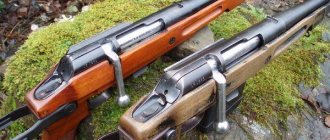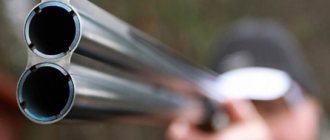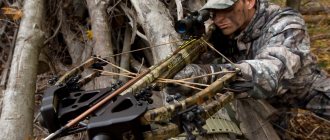Do you remember that Leskov’s Lefty asked him to tell the Tsar Father that the soldiers should not clean their guns with crushed bricks? Look, when did people in Rus' think about the abrasive properties of ceramics and the correct technologies for cleaning weapons!
Seriously, not so long ago, in remote places, trunks were simply “soaked” with boiling water, then chased away with a brush and wiped dry. But do not rush to accuse your ancestors of barbarism. The same operation is carried out for modern pneumatics for collective use in very advanced cases, when the barrel is so leaded that no chemicals or mechanical devices can handle it. Physics comes to the rescue: due to the difference in thermal expansion coefficients, lead flakes safely peel off from the steel.
I think that among the readers there are no enthusiasts of a bubbling kettle or, God forbid, an electric drill as a drive for a brush. And yet, how to properly clean a weapon and with what?
How and with what to clean a smoothbore gun, necessary equipment
If you are not an expert in choosing care products, it is better to consult a more experienced friend or consultant in a store. The contents of a gun care kit, whether it is a hunting or sporting one, may differ. It depends on the manufacturer, but some professional shooters ignore standard rules and select tools based on their experience and preferences. There may also be differences in tools and materials depending on the type of weapon, model, etc. The standard set includes:
- a wooden or aluminum cleaning rod consisting of 2-3 segments for cleaning and lubricating the barrel. Components are screwed to it: visers and brushes;
- iron brush for cleaning carbon deposits, metal particles and rust. There are bristle brushes, spiral brushes and down brushes. Tools made of either bronze or brass are considered to be the most durable in operational terms;
- brass brush with bristles for applying alkali-based lubricants;
- vishers are special tools with holes for holding rags. The visher is screwed onto the shomol;
- brushes for cleaning dirt and dust;
- wooden skewers for removing dirt in hard-to-reach places.
To clean the gun you will need a special cleaning rod.
Along with the tools, lubricants, neutral oils for processing carbines and shotguns, alkaline oils for barrels, and sprays for processing weapons are purchased.
Gun paste is also used. It acts as a neutralizer of active combustion products of gunpowder, removes carbon deposits and fights corrosion, and restores the shine of varnished and metal surfaces. However, due to the fact that the pastes contain abrasive particles, careless use can lead to damage to the bore. It is better to use pastes in the most advanced cases, when other means fail.
There are also additional means for caring for weapons: pencils for chemical blackening, wax, solvents, impregnation for caring for wooden parts, etc. You can combine products at your discretion, the main thing is the correctness and step-by-step execution of the manipulations themselves.
In addition to the devices described above, you can purchase a special stand for a gun and other accessories. You will also need a flat, well-lit surface.
How to care for your weapon? Basic postulates.
Just like the human body, a gun also needs care. Timely maintenance of mechanisms, including inspection, cleaning and lubrication operations, is as necessary for your weapon system as a daily shower is necessary for your body. Competent and regular routine maintenance of the mechanisms of your weapon not only extends the service life and resource life of individual mechanisms in particular and the entire complex as a whole , but also has a positive effect on the performance of mechanics/automation, quality and ease of use, and shooting performance.
Many people understand these statements, because, perhaps, everyone who purchases a weapon with their own money is interested in preserving their weapon in the most pristine condition. However, few understand how to ensure this and how to maintain weapons correctly and safely.
Of course, each type of weapon is equipped with accompanying documentation, which usually indicates how often and exactly how basic weapon care operations should be performed. However, such documentation is not always available. And the information in this documentation may not always be applicable in modern reality. Anachronisms in recommendations, and sometimes quite controversial advice on care can confuse not only a beginner, but also an experienced gun owner.
That is why the main advice in matters of weapon care at all times has been to adhere to two dogmas: “Think with your head” and “Do no harm.” These simple statements actually contain the sacred meaning of caring for any mechanism. After all, it is measured, intelligent and safe care for the weapon itself that is the best and most reasonable option for its maintenance. Undoubtedly, for example, bathing in RSF solutions can be a successful option for removing soot, however, no one knows what the effect of such procedures is in the long term.
Thrift is the key. It’s not for nothing that our great-grandfathers, grandfathers and fathers told us “Treat weapons like a spoiled woman or a picky child.” Indeed, it is better to be “safe than safe”, to spend more time and effort, but to be sure that it is safe and reliable (especially in relation to quite expensive samples), than to quickly and easily carry out care in the style of “Shoved, spat, blinked - and forgot” and grieve over the dead trunk.
Carefully store, transport and use your barrel - this is one of the main bases for the care and maintenance of any weapon , excluding subsequent operations of technical regulations. Careful storage and transportation in special cases or cases with a cap on the barrel, eliminating shocks and external influences, prolonged exposure to precipitation, storage in inappropriate conditions allows you to avoid labor-intensive, time- and money-consuming inspection, cleaning and lubrication operations, and will help preserve your weapon in the most pristine condition.
Even if your weapon can withstand being used as a hammer or nut cracker, being in a puddle of water that filled the Shishiga rut somewhere in the Krasnoyarsk Territory - treat it with care, with attention and do not allow (if possible) such harsh operating conditions - and it will be easier for you to care for it. Warn and exclude.
For the same purpose, it is worth excluding the use of low-quality cartridges in weapons (if such a possibility exists), which, in addition to the negative operation of the mechanisms and automation of the weapon, also negatively affect the weapon parts and lead to complex and difficult maintenance. Wear of parts, carbon deposits and other “delights” of using cheap and/or bad cartridges will lead to difficult inspection of mechanisms, complex and time-consuming cleaning, removal of old lubricant and application of new one. Use high-quality cartridges that are acceptable and recommended for your weapon, take only the best that you can find, even if you are omnivorous - and maintenance will be easier, and your life will be easier. Remember this.
If all this has been done, the operations of inspection, cleaning and lubrication, as the main ones in care, will be extremely simple and understandable, not too long - and even pleasant.
For example, a weapon inspection in this case is only a short visual inspection of the external and internal condition of the weapon - before and after use. No carbon deposits, wear and damage to parts (both external and internal), no loose parts, backlashes, jams, substandard operation of parts, etc. In addition, the presence/absence of lubricant, carbon deposits, lead and copper plating are visually monitored - that is, the cleanliness of the weapon is monitored. I repeat, visually - without the use of complex diagnostic tools.
Check and check that everything is intact and that everything works as it should. Monitor the integrity of the coating of external parts - for example, varnish on wood or bluing on the metal of the receiver. Check the weapon parts for play and looseness, and make sure that the swivels and sling are securely fastened. See if there is grease where it should be - and if there is grease where it shouldn't be. Make sure the quantity of lubricant (is there any excess) and its quality, the optimality of the lubricants used - their thickness and fluidity. Remove, if necessary, external and internal preservative grease, if any. Check the deposits before shooting and the deposits after firing.
Make sure that the sighting mechanisms, trigger operation, automation mechanisms, extraction mechanisms, and safety mechanisms are intact.
Complete the inspection operation.
If necessary (often after shooting), clean the barrel bore and weapon parts. Do not delay the cleaning operation, carry it out as often as you can - ideally after each shooting . However, carefully and accurately.
Use the included soft brushes and cleaning rods together with a soft, lint-free cloth - only natural. It is possible to use modern synthetic non-woven lint-free wipes for cleaning, etc. products, in certain situations, feminine hygiene products, such as tampons, etc., are also good for cleaning. products. For some cleaning parts, you can use so-called brushes and toothbrushes as cleaning agents; in some cases, riveted metal wire homemade cleaning rods are good.
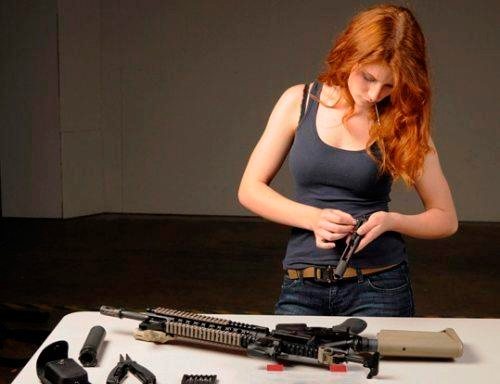
Remember the main rule - thrift, accuracy, expediency and lack of unnecessary effort. Clean those components and mechanisms that need to be cleaned - this is indicated in the recommendations and diagrams (cleaning and lubrication diagrams, they can be found on the Internet, for example, on specialized forums) for your weapon, often these are the barrel bore, chamber and some other parts. Use only barrel cleaning products that you are confident in. Use only what is safe for you and for the weapon.
Recommendations on cleaning products are unnecessary here - everyone cleans with what they are used to. Everyone also removes copper and lead plating using what he is used to. Some people use VD-40 and homemade cleaning products, while others are apologists for kerosene or transformer oil. Everything applies, choose what you like specifically - but remember the main rules.
After cleaning, lubricate the necessary mechanisms. Use the dry or liquid lubricant you like - it could be classic gun oil, Ballistol or something else. Apply a thin layer of lubricant, avoiding excess, which can thicken and collect dust, causing failure - remove excess with paper or cloth.
The issue of external lubrication is debatable. Many still believe that weapons, or at least their barrels, should be lubricated on the outside to protect them from moisture and precipitation - with a thin layer of thick lubricant. In this matter, proceed from a position of reasonableness and expediency: blued barrels, for example, clearly should not be lubricated due to the pointlessness of this matter - they already have a protective film of oxides. If the barrels of your weapon are made of “black” carbon steel without treatment, you can lubricate them with a thin layer of lubricant without unnecessary zeal.
If the weapon is placed in long-term storage, treat it (inside and outside) with a preservation lubricant.
The final, but not mandatory, stage of weapon care is its additional external processing. So, for example, waxed and impregnated wooden stocks can be renewed by additionally impregnating them with oil or wax. Wooden stocks coated with varnish, if they have losses in the paint and varnish coating, can be re-varnished - completely or partially, if necessary, after staining. Lost bluing and chipped paint on metal are also worth restoring.
The weapon maintenance cycle has been completed. How many more such cycles there will be, God alone knows. However, let's hope that thanks to our advice there will be a lot of them (which will indicate a long life of the weapon) and they will only be a joy!
Why do hunting weapons get dirty?
The reasons why a hunter's weapon becomes dirty are quite obvious. Forests, steppes, swamps, fields do not in any way resemble a scientific laboratory or a sterile hospital ward. No matter how carefully the gun is used during hunting, no matter how comfortable the conditions are when it is transported, its metal parts in the open air will inevitably come into contact with moisture and other unfavorable factors. And if you are unlucky with the weather or the weapon falls out of your hands...
In addition, cleaning the gun is necessary for another reason. The fact is that when fired, the barrel experiences high pressure and high temperatures. Hot gases and particles of burning gunpowder lead to the formation of “rashes” on the inner surface of the barrel - small pockets of rust that tend to further develop into shells. Soot from black powder has the property of attracting moisture.
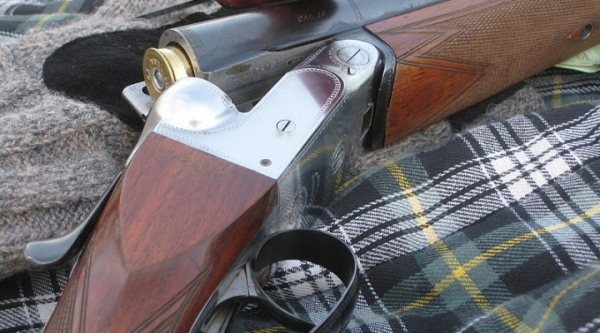
In addition, cleaning smooth-bore weapons, like rifled weapons, allows you to get rid of soot, scale and so-called copper plating - residues of particles of a bullet or other ammunition in the bore. And although there is no universal answer to the question of how to properly clean a hunting rifle, it is strongly recommended to follow the basic principles.
Let's start with the trunk
The key element of any gun is the barrel. Before the cleaning process itself, we prepare the working surface, which must be flat. Use a soft surface that will prevent the weapon from being scratched. Newspapers are also suitable because they absorb oil and combustion products from cartridges just as well. Provide a resting point for the muzzle before using the cleaning rod.
The disassembly process is as follows: we separate the receiver block from the box. If the gun is fractured, then the fore-end is first removed, after which the block is carefully removed. We support the butt with our free hand. Everything needs to be done above the table.
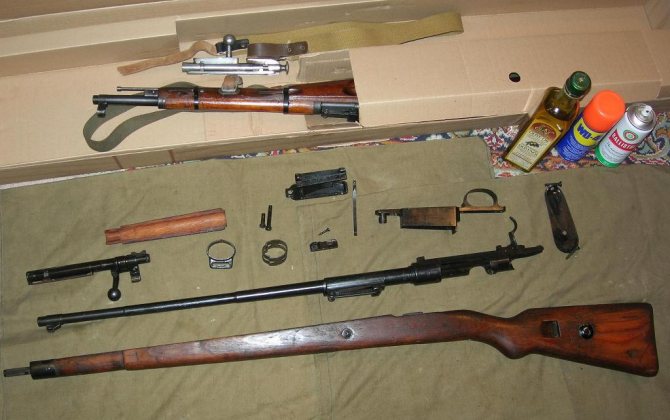
Semi-automatic machines are equipped with a cap screwed onto the magazine. It is the key fixator of the entire structure. Carefully unscrew it, move the bolt back 2-3 centimeters, remove the forend and pull the receiver unit with the butt in different directions (necessarily above the table). Beginners are advised to take photographs of the parts inside the forend so as not to become confused in their location in the future. The slightest mistake can lead to unstable operation of the gun.
We unscrew all the narrowings. Now you can begin to bring the weapon to its original condition in two ways:
- using old technologies;
- according to new ones.
Let's consider the advantages of each.
Cleaning the old fashioned way
So, we have prepared the barrel, now we will clean it using the “traditional” method. You will need special oil or lye, sold in gun stores. Apply it to the inner surface for about 20 minutes until the substance softens and prepares powder deposits.
Next, remove the lead with a steel brush until a characteristic mirror shine appears inside. After rough processing, take a napkin or a soft (preferably fiber) cloth and remove the remaining lead. Wipe the barrel dry.
Modern trends
Progressive cleaning is not much different, but the method is more convenient. The barrel is filled with foam (from the same store) and kept for up to 20 minutes. The composition is caustic; work only with rubber household gloves. Foam easily dissolves lead, copper plating and combustion products “sticking” to the inside of the barrel.
Next, a cleaning patch is screwed onto the cleaning rod. Unlike a rag, it fits tightly to the walls of the barrel, ridding it of the smallest particles of dust and dirt. Finally, wipe off all oil residues with a cloth.

Gun cleaning compounds
How do you clean weapons? This question interests many beginners. Three types of compounds are used during the procedure:
- solvents;
- cleaning pastes;
- oils
Turpentine, kerosene and various compounds based on it, diesel fuel, and carburetor cleaners can be used as solvents. Modern solvents remove carbon deposits and other contaminants from the bore more effectively.
Pastes are the most powerful weapons cleaning products . In addition to solvents, they contain abrasive materials. Therefore, if you use pastes carelessly, you can cause significant damage to the barrel of the gun. They should be used only in the most severe cases, with severe stains that cannot be cleaned using conventional methods. They are also used after firing molybdenum disulfide coated bullets. Abrasive pastes clean the barrel very well, but when used, its internal diameter can increase, and this leads to a significant reduction in the service life of the gun.
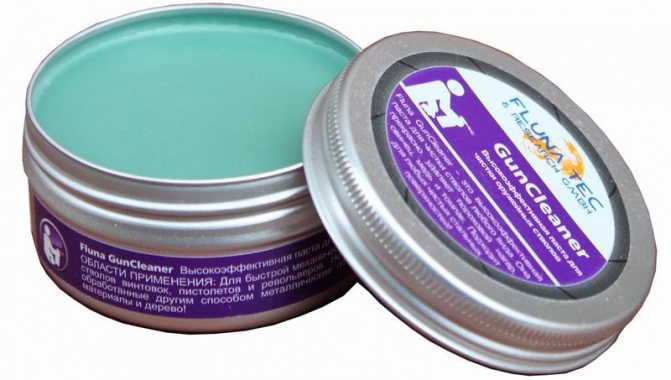
If twenty years ago only two types of oils could be found on sale - alkaline and neutral - today their choice is very large. Among them there are products that were developed specifically for lubricating weapons. Other types of oils are also suitable for this purpose, such as synthetic automobile oil, which does not freeze in the cold.
The use of neutral oils eliminates the aggressive environment that occurs in the bore after the use of reagents used for cleaning. They also protect the metal from corrosion. Alkaline gun oil, which was once widely used for bore cleaning, is rarely used today.
How to handle a gun while hunting?
Of course, cleaning and lubricating your gun is important. But handling also plays a big role. After all, if you work with the gun carefully, you will have to clean it less, and in this case the gun itself will last longer thanks to good attention. So, if it fell to the ground, then without delay, you need to check whether there is snow or soil in the bore. If present, they should be promptly cleaned. If contaminants are present and the gun is fired, there is a risk of the barrel bursting or swelling. Also, when loading it after shooting, it is always necessary to check whether there is a wad or cartridge case inside that has come off the cap (or part thereof). You also cannot finish off a shot animal or bird with a weapon, as well as take game out of the water. Such actions have only one result - damage. If you are now at a halt, then you need to unload the gun. Then hang it with its trunks down on a branch. For convenience, strength and reliability, it is recommended to cut it so that it can support the weight of the gun. At the same time, it should hang freely. After all, if a carbine or smoothbore gun is leaned against a tree, it can fall to the ground because there will be a fulcrum with which the wind will throw it off.
Cleaning rifled weapons
Basic rules for cleaning rifled weapons:
- Rifled weapons should be cleaned in the following sequence: first the breech, then the muzzle. That is, in accordance with the direction of flight of the bullet;
- The cleaning rod should also move in the same direction - from the breech to the muzzle. In this case, it is recommended to change the patch (a special napkin rolled onto the wipe, called a visher) more often. The patch is a disposable device, so it is not recommended to use it repeatedly;
- It is not recommended to move the cleaning rod for cleaning weapons in the “back and forth” mode. This may cause scratches inside the barrel. Moreover, the brush and patch are easily clogged with particles deposited on the walls of the barrel;
- The brush for cleaning weapons should be chosen not soft, but hard. Soft bristles very quickly become clogged with hard carbon deposits settled inside the barrel, and it is very difficult to remove it from a soft brush. On the contrary, a brush with a stiff brush is much more effective in this sense, since it cleans the inside of the barrel more reliably. In this case, you need to ensure that the brush remains dry (as well as the patch), otherwise, again, residual particles in the barrel bore will stick to them;
- It is advisable to clean your weapon immediately after shooting. It is highly recommended not to postpone cleaning until the next day. The reasons for this requirement were discussed above;
- It is necessary to periodically clean the weapon even if no shooting has been done from it. In this case, the lubrication is not so intense;
- If the weapon was fired, then, as stated, it should be cleaned immediately after firing. After 2-3 days, the weapon must be cleaned again, and after another 2-3 days - a third time. And only then can rifled weapons be stored for a long time, but it should be remembered that even during long-term storage they must be periodically cleaned;
- It is most necessary to clean the muzzle part and the bullet entrance - as the most “easily damaged” parts of the barrel;
- When cleaning rifled weapons, it is very undesirable to use a variety of “homemade” products: homemade compounds, lubricants not intended for weapon cleaning. You cannot use homemade alkaline compounds; you also cannot immerse the weapon or its individual parts in highly alkaline solutions. Such an amateurish approach to cleaning weapons can simply ruin the weapon;
- After cleaning, the gun barrel, as well as all cleaned components and mechanisms, must be lubricated with gun oil.
To clean your weapon more efficiently, you can use a stand or a weapon cleaning machine. These are special devices on which the weapon is conveniently fixed. In addition, the machine and stand have special niches for storing gun oils and other cleaning and lubricating products. At the same time, the stand for cleaning weapons is very compact, so if you wish, you can take it with you even when hunting or to shooting sports competitions. You can make it yourself, or you can buy a branded one.
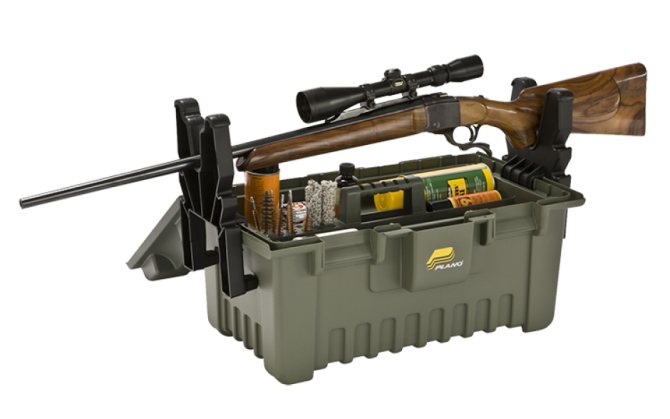
Professionals and amateurs: the difference in approaches
In order to avoid omissions, let’s say right away that there are a lot of legends, myths and opinions in this area of knowledge. The most radical of them: cleaning weapons is harmful. As a rule, it is followed by those who have ruined the barrel or bolt group through incorrect actions, for example, the wrong choice of lubricant. Or - you will laugh - owners of models with extremely difficult disassembly/assembly and access to the breech.
The author belongs to the group of “moderates” who believe that excessive enthusiasm for cleaning and lubrication, especially without a critical understanding of the essence of the processes, also does not lead to good. This is mainly due to long-standing experience, when shooters had at their disposal kerosene (then the super-product WD-40), an alkaline compound and neutral oil. Weapons maintained with the help of these components have served faithfully and continue to serve for many decades, failing for reasons not related to the chemistry used and the frequency of hygiene procedures. I note, however, that all this applies to serial domestic shotguns, albeit high-quality ones, as well as to civilian versions of army rifles - OP-SKS, "Tiger", numerous "Kalashoids".
With the advent of specialized chemicals, especially aerosol ones, on our shelves, everything has become even simpler. For example, the same legendary “Ballistol” allows you, after a day full of shooting and rain, to simply wipe all the iron, fill it inside and out with this spray and not worry about anything else until you get home, where you can clean it in a more comfortable environment.
And finally, “maximalists”, most often fans of high-precision shooting. People of this type practice thoroughness in everything. As a rule, they prefer a table covered with newspapers, albeit a compact one, but still a center for cleaning. For example, such as in the photo, the extremely inexpensive “Portable Maintenance Center”.
And it’s hard to disagree with them. Look how thoughtfully and conveniently everything is done.
When you read the recommendations of adherents of “high precision”, you are amazed at the perseverance and scrupulousness, the purely scientific approach to removing various types of contaminants. Can you imagine what kind of practical experience and surgical precision of movements you need to have in order to remove copper plating on match barrels using abrasive pastes!? Their arsenal of techniques includes, for example, the selection of chemicals for cleaning different AREAS of the chamber, methods that provide for special cleaning after EVERY shot, the use of substances that are neutral to some barrels, but literally dissolve the metal of others. In a word, if you have a burning desire to become a real BR shooter, you shouldn’t engage in guerrilla warfare - come out of the forest to people and join a team of like-minded professionals. Moreover, there is no “benchrest” without regular competitions.
For the majority of people, all this is somewhere on the other side of good and evil. Therefore, let us be guided by the condition “necessary and sufficient” known from mathematics. Without stopping at the basics of preliminary procedures, such as the need to unload and disassemble the weapon, prepare all the necessary accessories, etc., the entire cleaning process can be divided into three stages.
How to clean - step by step instructions
In order not to harm the weapon by violating the integrity of the internal coating of the barrel, all movements of the cleaning rod along its bore should be made from the breech towards the muzzle. If you ignore this important rule, then you can’t even dream about the long service life of the gun.
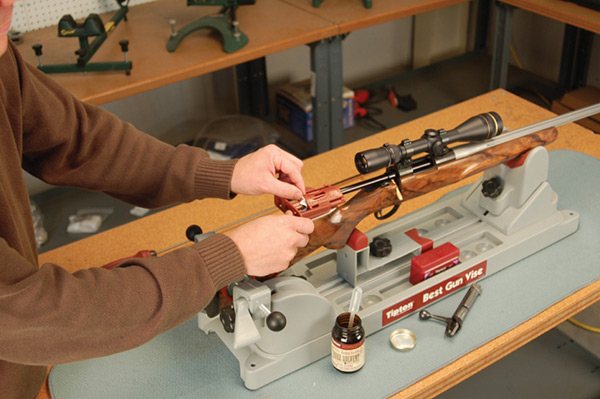
So, preparing the gun for cleaning and the cleaning itself must be performed in the following sequence:
- We put the weapon on the table and unload it. We remove the magazine and cartridge from the chamber. After this, we proceed to its incomplete disassembly (how this procedure is performed, again, can be learned from the numerous useful videos that abound on the Internet). Bring a gun cleaning kit to your work area.
- We apply alkaline grease or spray to the inside of the bore, and do this from the breech. We fix the weapon in a vertical position for half an hour. It is necessary to lubricate in a similar way not only the barrel, but also other parts that are affected by powder gases. This is, in particular, a shutter, a gas engine, etc.
- Wrap the patch around the visher and wait until the alkaline lubricant, having passed through the entire barrel, flows down at the muzzle. Use the prepared patch to wipe off any remaining residue and initial carbon deposits.
- Take a brush that matches the diameter of the bore. Move the brush over it in one continuous continuous movement (without stopping or sudden jerks). Inexperienced gun owners sometimes clean the barrel with reciprocal movements, that is, by moving the brush back and forth. This should not be done under any circumstances, since such tactics can lead to negative consequences. More specifically, this is fraught with damage to the barrel.
- We wrap a new patch on the visher and dip it into a solution or special liquid. We use a damp patch inside the barrel, wiping it dry.
- We repeat these steps again - clean with a brush, then wipe with a patch. This must be done exactly until the moment when, after wiping with the patch, soot particles are visible on it.
- Having finished cleaning the bore, you need to give the chamber its former cleanliness and original appearance in the same way. We now pay attention to caring for it. We alternate working with a brush and a visher with a wound patch. We do these simple manipulations exactly until traces of carbon deposits stop appearing on the patch.
- Next, take a new patch and dip it in the oil solution. We wipe the barrel bore with this patch, after which we use a clean patch to carry out its final processing.
- So, we cleaned the bores, but cleaning a weapon also means caring for other parts of the firearm. They need to be cleaned a little differently - using only wet patches and dry ones. First wipe wet, then wipe dry, and so on several times, until that wonderful moment until the part is completely clean.
- We assemble the weapon into its working condition.
- After cleaning, we recommend covering parts made of metal with a neutral lubricant or anti-corrosion agent.
If you have cleaned the gun in accordance with our instructions, then at least it will not be in danger in the near future and will function as expected. Do not forget to carry out this procedure regularly, and then the gun will reward you for your efforts and careful attitude with a long service life, during which you will not be able to make absolutely any claims to its functional condition, since everything will work at five plus.
How to properly clean a gun: step-by-step instructions
Before cleaning a smoothbore gun, it is necessary to carry out preparatory measures:
- unload the gun and check it before cleaning, remove any remaining leaves and visible dirt;
- if you brought the gun from the cold, then you need to let it sit at room temperature for 3-4 hours to prevent condensation;
- The weapon is always cleaned from the chamber to the muzzle. The cleaning tool should only move in one direction. During the cleaning process, solid particles are always formed that must be quickly removed;
- tools and the bore must be dry during cleaning;
- the cleaning rod should have a soft coating, preferably plastic or wood. You cannot use metal cleaning rods, especially those with an aluminum coating;
- alkaline lubricants are applied to surfaces with which powder gases came into contact outside and inside the barrel;
- weapons are cleaned in a well-ventilated area, because cleaning compounds are highly toxic and volatile. In order not to damage the table surface with the chemical components of the lubricant, it is better to cover the work surface with newspapers in 5-6 layers;
- Cleaning cloth pieces are used only once and are discarded forever.
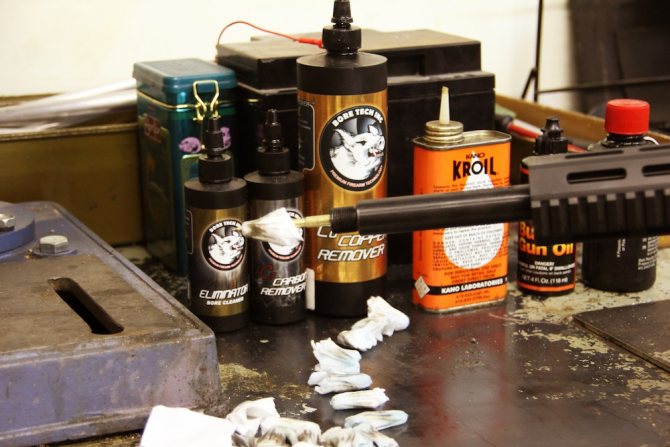
After preparation, you can proceed directly to the cleaning process.
- Depending on the type of gun, the barrel is broken or dismantled. If the gun has just been purchased and you do not know how to do this, look at the manufacturer's instructions.
- Alkaline lubricant or spray is applied to the inside of the bore on the breech side. The weapon is fixed in a vertical position for half an hour. Other parts exposed to powder gases are lubricated in a similar way.
- After the lubricant has passed through the entire barrel and flowed down at the muzzle, wipe it off using a cloth cutter and a whisk.
- A metal brush corresponding to the diameter of the barrel bore is screwed onto the cleaning rod and with its help the internal cavity of the barrel is cleaned several times. This removes lead, which causes rapid corrosion. Don't move back and forth. Cleaning is carried out only in one direction, otherwise the barrel may be damaged.
- The place of the brush is again taken by a brush with a rag. With its help, all internal dirt is cleaned until all traces of lead are removed. If after 3-4 manipulations the marks do not disappear, you can moisten the cloth in kerosene or turpentine and repeat the procedure.
- A bristle brush dipped in lubricant is screwed into place in place of the visher. The lubricant is evenly distributed throughout the barrel bore.
- The external elements of the weapon are also cleaned of dirt and dust with a brush and wiped with a cloth slightly moistened with oil.
- Wooden parts are wiped with compounds specially designed for wood.
- Upon completion of cleaning, check the presence of lubricant on the wood of the stock and forend to see if it has been absorbed into them.
- The cleaned gun is collected, packaged and sent to a safe for storage.
After cleaning, all tools except the cleaning rod are washed in warm running water and soap to completely remove any solid particles. Then they are dried well, folded and put away in a specially designated place for them.
A rifle is a rifle that can be cleaned from the treasury, but a semi-automatic can be cleaned from the muzzle. The procedure is the same as when caring for a smoothbore gun.
Criteria for indications for cleaning
Opinions vary on how often to clean a gun. Some believe that too frequent cleaning will damage the inner chrome layer and leave scratches. This theory has not been confirmed, so it is recommended to clean a hunting rifle in the following situations:
- weapons are not used for a long time. In this case, cleaning is recommended once a month;
- after zeroing, and the barrel must be cleaned after each shot fired;
- immediately after purchase, to get rid of factory lubricants;
- after the hunting season closes, before hiding;
- after each use, even if only a few rounds were fired;
- after moisture and dirt get into the gun;
- after the hunt, regardless of whether a gun was used or not.
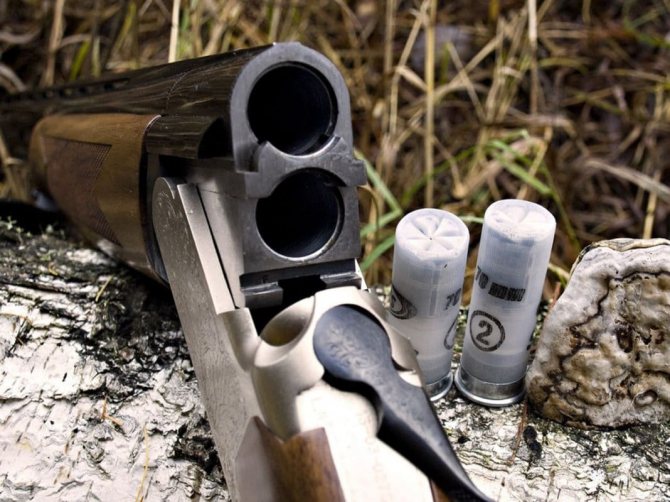
It is necessary to clean your gun after every hunt.
You can leave a gun uncleaned for no more than a day, because... corrosion begins to appear 2-3 hours after shooting. These easy-to-remember rules will help preserve the life of your weapon for a long time.
Cleaning and lubricating a hunting rifle
How often should you clean your gun?
Cleaning and subsequent lubrication of the gun is necessary in the following cases:
- during long-term storage, - in case of contamination and water, - after shooting.
Most hunters consider it correct to conduct it immediately after the hunt or some time later. Although I know several people who do it only a couple of times a season, explaining that frequent cleaning is harmful and leads to scratches and a thinning of the chrome layer. Well, in this case, as the master says, everyone decides for himself when and how many times to clean the gun, the main thing is that it is always in good condition.
Unfortunately, no matter how carefully a hunter treats his gun, it will still wear out after some time. First of all, barrels are subject to destruction and this happens for the following reasons: interaction with gases contained in the air, due to the high temperature and pressure that accompany each shot, due to particles formed during the combustion of the igniter composition and gunpowder. As a result, a rash soon appears - small pockets of rust, which can then develop into shells. Therefore, if after a hunt for some reason there is no time for a full cleaning, it is worth at least cleaning the barrels of carbon deposits.
You can leave a gun uncleaned for no more than one day, because... corrosion processes begin already 2-3 hours after shooting
Cleaning accessories
Cleaning rod—used for cleaning and lubricating barrels. The most commonly used material is portable, consisting of 2-3 elbows, wood or aluminum.

1
Metal brush - used to remove hardened carbon deposits, lead residues and rust from barrels.
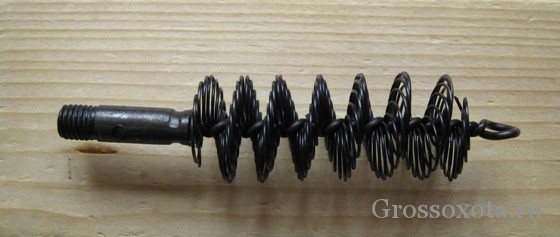
2
Bristle brush - applying alkaline lubricant to the walls of the bores.

3
Puff - applying neutral lubricant.

4
Vishers are screwed onto a cleaning rod, and rags or a clean rag are wound around them.

5
Oil can with gun oil.
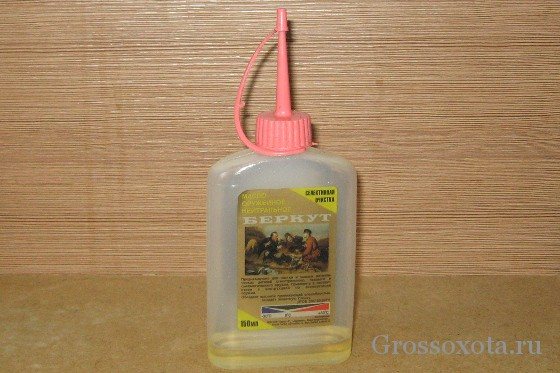
6
Brush—for sweeping debris out of gun mechanisms (for semi-automatic weapons).

7
Sharp sticks - remove dirt and old grease from narrow crevices.
Cleaning procedure
During the cold season, a gun can only be brought indoors in a case or wrapped in something. You can start cleaning no earlier than after 3-4 hours, when the temperature of the metal of the gun gradually equalizes the temperature of the room. This will prevent the formation of condensation. In warm weather, you can start cleaning right away.
The first thing you need to do is make sure that the gun is unloaded, be sure to pay attention to this
More than once I have heard from hunters with extensive experience behind them how a shot turned out during cleaning. They themselves later wondered how this could happen, since they had long been in the habit of unloading their weapons after a hunt.
After checking, we carry out a visual inspection, clean it of dirt, dust and forest debris. Next, we disassemble it; the degree of disassembly depends on the model and the nature of cleaning - partial or complete.
If you have just purchased a gun, or if you have any doubts, you should find information about the diagram and rules for disassembling this model. It is often better not to touch some mechanisms; it is enough to simply lubricate them. For classic over-and-under and horizontal guns, this process is quite simple and comes down mainly to cleaning and lubricating the barrels and gun blocks.

8
For self-loading semi-automatic machines, the process takes much longer, because They are almost completely disassembled and every detail requires care. The cleaning sequence is chosen by the hunter himself.
Cleaning of barrels is carried out from the breech side (chamber). We wrap a rag around the assembled cleaning rod and clean the bore of carbon deposits. Next, if lead or rust is present, remove it with a metal brush; in this case, you can pre-lubricate the channel with alkaline oil to soften unburned residues. After some time, it must be removed with a dry cloth, because it can further damage the chrome layer.
Cleaning is carried out until no dirt appears on a clean, dry cloth after wiping the barrel. Having achieved this, apply a thin layer of neutral oil. In the future, before hunting, it will be better to remove it.
If necessary, sweep out debris from the remaining mechanisms and components of the gun with a brush, clean it of dirt and old grease, wipe it with clean rags and lubricate it with oil. We wipe the outer surfaces of the blocks and barrels with an oily cloth, while not allowing the lubricant to get on the wooden parts of the gun.
Old guns may have small shells; dehydrated kerosene can be used to clean them.
Accessories for cleaning and lubrication can be purchased at any hunting store.
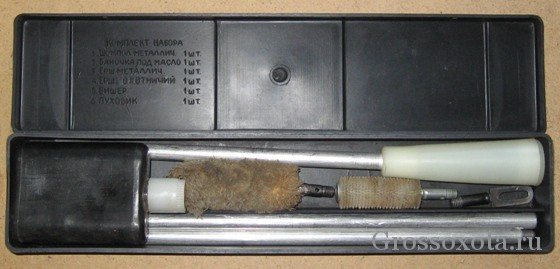
9
Take care of your gun and it won't let you down.
And finally, we present to your attention a short video about a convenient device for cleaning a gun in the field.
When to clean
There is a fairly common misconception that says that frequent cleaning is harmful to the gun, as it leads to scratches, abrasion of chrome surfaces, and so on. It should be noted that if you neglect basic tips on how to properly clean a gun, then an expensive weapon can break down much faster - within a couple of years.
Experts recommend cleaning your weapon at least once a month, even if it has not been used.
In addition, there are strong recommendations, including from manufacturers, when cleaning is simply necessary:
- after purchasing a new gun;
- in the process of shooting it;
- after every hunt;
- at the end of the season.
Cleaning the weapon immediately after purchase allows you to get rid of smudges of factory lubricant. In addition, this is another reason to carefully inspect the weapon in a calm environment, check the operation of the trigger mechanism on a spent cartridge case, and make sure the quality of the weapon’s assembly.
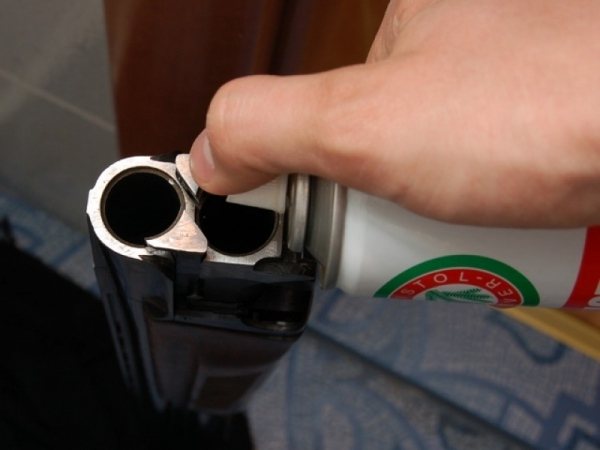
When zeroing on a stand or in a nearby ravine, the gun is cleaned literally after every shot. When using cartridges with smokeless powder, it is recommended to carry out hygienic procedures at every long rest, and when shooting with black powder - immediately after a hunt.
During the off season, the gun is, of course, not used. But this does not mean that it is guaranteed to be free from moisture and corrosion. It is advisable to carry out cleaning and lubrication monthly.
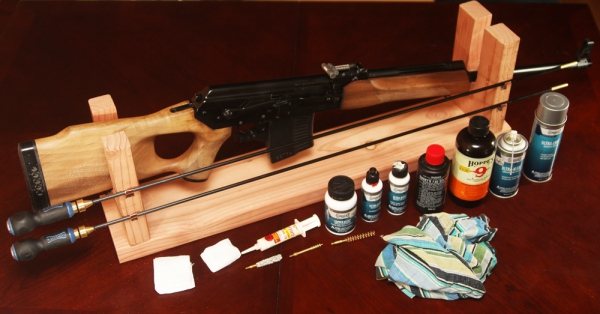
Cleaning your gun after hunting
Cleaning your gun after huntingThe main care of the gun, ensuring its good service for many years, begins after the hunt.
The basic rule of this care is that the gun should be cleaned immediately upon returning from hunting, and not postponed until another day, much less for a long time.
Cleaning should consist of the following.
First of all, the barrels are separated from the stock, and the forend from the barrels. Wrap a soft rag or a sufficient amount of cleaned tow around a visher screwed to the ramrod and wipe the inside of the barrels several times, freeing them from the first layer of powder soot, adhering remnants of wads and surface, easily removable lead. Then a bristle brush is attached to the cleaning rod and, without soaking it in anything, except alcohol, if any, carefully pass it along the trunk many times.
If after this inspection of the barrels shows the absence of dark spots and the same longitudinal stripes, especially now behind the chambers and at the exit in the chokes, then, after drying the inside of the barrels with a clean rag or a new portion of tow, you can proceed to lubricating them.
If, after using a bristle brush, traces of soot or dark spots from adhering lead are still noticed in the trunks, then you need to use a copper brush and, having generously moistened it with oil, pass it through each trunk many times, warming it up and lingering on the spots of the noticed spots.
Having completely cleaned the gun and wiped it two or three times with a dry cloth, screw a powder puff onto the cleaning rod and lubricate the barrels with a thin layer of oil.
All brushes used to clean the gun must be wrapped in a rag after use, each item separately, and placed in a special bag or box. This should be done so that dust does not accumulate in the brushes and puffs, which, if introduced onto the brushes into the barrels, can scratch the polishing of the latter.
If there was a lot of shooting, especially in dry and even hot weather or with the use of bad, poorly salted wads, then it happens that there is so much carbon deposits and it “sticks” so tightly to the barrels that after the first wipe with a rag the metal will shine in places, and in others dark, stubborn dirt will still remain. Then the rag (or tow) should be moistened with denatured alcohol or purified kerosene or simply boiling water, which perfectly softens carbon deposits and newly formed rust.
You need to clean kerosene from water as follows: pour a spoon or a little more ordinary table salt into a bottle of kerosene and, having sealed it, leave it in the light for a day. Trying not to shake it, the kerosene is poured off, leaving about half a glass at the bottom along with the salt. This drained kerosene is completely clean and suitable for caring for your gun.
Densely adhered lead can also be removed in this way. Having wound so much tow on the visher that it moves quite tightly in the trunk, they pour turpentine over the wound and rub the trunk repeatedly with such force that it heats up quite noticeably. This is a very good technique if the hunter for some reason does not have a copper brush.
Having finished cleaning the inside of the barrels, wipe them outside several times with an oiled rag, especially making sure that there is no dirt, dust or dampness left in the place where the strip is soldered to them.
Next, the breech and muzzle ends of the gun are wiped with the same rag.
During ordinary cleaning, there is no need to unscrew the extractor, but, having extended its legs as far as they will go, pass between them and. the tip of an oiled rag with the barrels and thoroughly wipe both the legs all around and the plane of the barrels where the extractor fits flush so that there is no dirt or traces of powder residue left between it and the plane of the extractor. After this, the extractor legs should be lightly lubricated so that they move freely in their sockets.
The hooks of the barrels with which they enter the block must also be thoroughly wiped with a rag.
Having finished with the barrels, you need to carefully wipe the block with an oil rag and especially its back (on which the cartridges rest when the gun is closed) and the cushions, i.e. the planes on which the barrels rest. On the back, copper traces from the cartridge case often remain around the firing pins, and these traces must be removed. In the corner formed by the back of the block and its cushions, a layer of dirt usually accumulates from soot that gets there; it should be cleaned.
You should not grease the entire stock with an oil rag, especially in places where locks and other metal parts are inserted. If you ever had to glue a broken piece of wood here, the wood that is constantly oiled will not accept the glue. The butt itself is best wiped lightly with linseed oil from time to time.
To lubricate the inside of the barrels, it is best to use only some special oil. Such oils are produced and sold in gun stores. Sewing machine oil is very good for lubricating locks and rubbing parts of a gun.
Under no circumstances should you use various vegetable oils (wood, sunflower, etc.) to lubricate weapons, and you should also not use ordinary beef, much less salted, lard for this purpose.
Complete disassembly of the gun and cleaning and lubrication of locks (hammer and non-hammer locks are the same) should be done as rarely as possible and only in cases of extreme necessity, for example, if the gun fell into water and lay there for some time. If the locks are well inserted into the wood and provided that the strikers do not penetrate through the pistons and gases do not penetrate into the mechanism of the gun, the locks can serve regularly for several years without inspecting them or lubricating them.
In shotguns of mediocre quality, where the fit is not so good, the locks can be cleaned once a year and lubricated with a very thin layer of the special oil discussed above.
On bolt-action shotguns, such as Berdankas, the bolts should be cleaned and lubricated more often. But in winter it is better not to lubricate them at all. All lubricants usually thicken in the cold, and this can cause annoying misfires during the most important shot.
Never and under no circumstances should you use sandpaper when cleaning a weapon. It can only be useful in the hands of an experienced craftsman, but in the hands of an ordinary hunter it is a sure way to damage weapons.
You should never clean your gun halfway. It is better to postpone this work altogether than to do it haphazardly or incompletely.
Why should you clean your gun?
After the shot, soot remains on the channel walls, which consists of solid residues of gunpowder and the primer. It is formed in large quantities during the combustion of black powder. Smokeless formulations, in turn, release a small amount of solid residue at the moment of ignition. But the formation of soot in small quantities also occurs during their use.
The combustion products of gunpowder, which remain on the bore, well attract water in the air, as well as water entering the gun during rain, snow or dew. As a result, the weapon begins to rust.
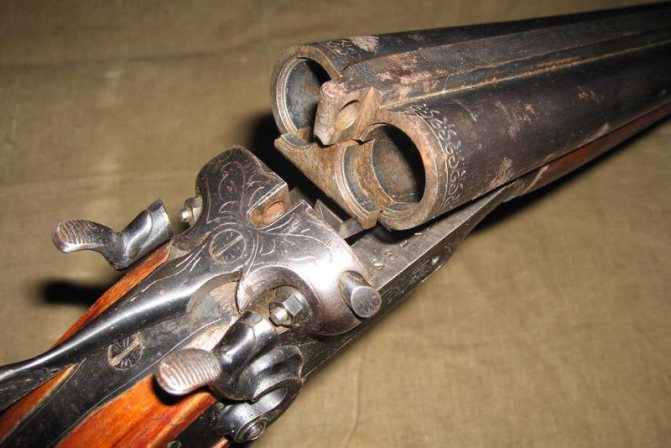
Particularly harmful in this regard is the soot that remains from the primer. To prevent rust, the gun should be cleaned as soon as possible after shooting. This procedure also avoids so-called copper plating, which is caused by particles from bullets and other ammunition remaining in the barrel.
In addition, the fields, swamps and forests that hunters go around in search of trophies cannot be called sterile spaces. Even if you handle the gun carefully and carefully, it will be exposed to moisture, dust and other adverse factors.
Therefore, the gun must be cleaned after every hunt. In addition, this procedure is recommended:
- after purchasing a new weapon;
- during the shooting process;
- after the end of the season before storing the gun;
- once a month during storage.
The idea that frequent cleaning harms the gun is wrong . Careful care of your weapon allows you to maximize its service life.
Immediately after purchase, during cleaning, you can remove excess factory lubricant, and also carefully inspect the purchased weapon, make sure the quality of its assembly and check the operation of the trigger mechanism. When zeroing, you need to clean the bore after each shot. Periodic cleaning and lubrication of the gun during storage allows you to avoid the appearance of rust, since even at this time the weapon is not completely free from contact with moisture.
Features of caring for a hunting rifle
The hunting process does not take place in laboratory conditions. In forests and swamps, on the banks of rivers, lakes and seas, weapon metal comes into contact with moisture, dust and sand. Water, especially sea water, is dangerous because it causes rusting of all metal parts. At first these are small dots, which quickly turn into chips, and then into shells. Well, dust and sand work as a full-fledged abrasive, causing scratching and mechanical abrasion of weapon parts.
The use of black powder is especially dangerous - it produces an order of magnitude more soot than smokeless gunpowder, and this soot has pronounced hygroscopic properties (pulls moisture out of the air). Another dangerous point characteristic of smooth-bore weapons is the possibility of breakthrough of combustion products of the primer when the paper sleeve ruptures. They not only have a strong rusting effect, but also form carbon deposits in the barrel and on the block, and also penetrate into the locks.
In addition, when using unsheathed lead bullets or shot, the barrel may become leaded; when using jacketed bullets, there is a possibility of copper plating (although this problem is more typical for rifled weapons). The worse the condition of the surface, the higher the rate of lead formation; the presence of numerous shells is especially unfavorable in this regard.
In this regard, it is recommended to carry out at least two cleanings:
- draft - at every long rest and immediately after the end of the hunt;
- finishing - immediately upon returning home.
During hunting, extraordinary cleaning may also be required: if the gun falls or you drop it, you need to unload it and make sure that no earth, sand, dirt or snow gets inside the barrel, because when fired, a partially clogged barrel can swell or even rupture.
In addition, during the off-season, when hunting is not carried out, it is recommended to carry out preventive cleaning and lubrication of weapons at least once a month.



